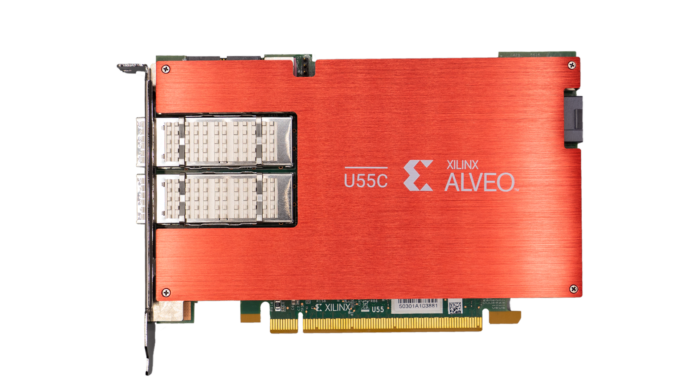Bengaluru, Nov. 16, 2021 – Xilinx, Inc. (NASDAQ: XLNX), the leader in adaptive computing, today at the SC21 supercomputing conference introduced the Alveo™ U55C data center accelerator card and a new standards-based, API-driven clustering solution for deploying FPGAs at a massive scale. The Alveo U55C accelerator brings superior performance-per-watt to high-performance computing (HPC) and database workloads and easily scales through the Xilinx ® HPC clustering solution.
Purpose-built for HPC and big data workloads, the new Alveo U55C card is the company’s most powerful Alveo accelerator card ever, offering the highest compute density and HBM capacity in the Alveo accelerator portfolio. Together with the new Xilinx RoCE v2-based clustering solution, a broad spectrum of customers with large-scale compute workloads can now implement powerful FPGA-based HPC clustering using their existing data center infrastructure and network.
“Scaling out Alveo compute capabilities to target HPC workloads is now easier, more efficient, and more powerful than ever,” said Salil Raje, executive vice president, and general manager, Data Center Group at Xilinx. “Architecturally, FPGA-based accelerators like Alveo cards provide the highest performance at the lowest cost for many compute-intensive workloads. By introducing a standards-based methodology that enables the creation of Alveo HPC clusters using a customer’s existing infrastructure and network, we’re delivering those key advantages at a massive scale to any data center. This is a major leap forward for even broader adoption of Alveo and adaptive computing throughout the data center.”

Important Announcement – EasyShiksha has now started Online Internship Program “Ab India Sikhega Ghar Se”

Built for HPC and big data applications The Alveo U55C card combines many key features that today’s HPC workloads require. It delivers more parallelism of data pipelines, superior memory management, optimized data movement throughout the pipeline, and the highest performance-per-watt in the Alveo portfolio. The Alveo U55C card is a single-slot full-height, half-length (FHHL) form factor with a low 150W max power. It offers superior compute density and doubles the HBM2 to 16GB compared to its predecessor, the dual-slot Alveo U280 card. The U55C provides more compute in a smaller form factor for creating dense Alveo accelerator-based clusters. It’s built for high-density streaming data, high IO math, and big compute problems that require scale-out like big data analytics and AI applications.
Leveraging RoCE v2 and data center bridging, coupled with 200 Gbps bandwidth, the API- driven clustering solution enables an Alveo network that competes with InfiniBand networks in performance and latency, with no vendor lock-in. MPI integration allows for HPC developers to scale out Alveo data pipelining from the Xilinx Vitis™ unified software platform. Utilizing existing open standards and frameworks, it’s now possible to scale out across hundreds of Alveo cards regardless of the server platforms and network infrastructure and with shared workloads and memory.
Software developers and data scientists can unlock the benefits of Alveo and adaptive computing through the high-level programmability of both the application and cluster utilizing the Vitis platform. Xilinx has invested heavily in the Vitis development platform and tools flow to make adaptive computing more accessible to software developers and data scientists without hardware expertise. The major AI frameworks like Pytorch and Tensorflow are supported, as well as high-level programming languages like C, C++, and Python, allowing developers to build domain solutions using specific APIs and libraries, or utilize Xilinx software development kits, to easily accelerate key HPC workloads within an existing data center.
HPC customer use cases CSIRO, an Australian national lab with the world’s largest radio astronomy antenna array, is
utilizing Alveo U55C cards for signal processing in its Square Kilometer Array radio telescope. Deploying the Alveo cards as network-attached accelerators with HBM allows for massive throughput at scale across the HPC signal processing cluster. The Alveo accelerator-based cluster allows CSIRO to tackle the massive compute task of aggregating, filtering, preparing, and processing data from 131,000 antennae in real-time. The 460GBs of HBM2 bandwidth across the signal processing cluster is served by 420 Alveo U55C cards fully networked together across P4-enabled 100Gbs switches. The Alveo U55C cluster delivers processing performance with overall throughput at 15Tb/s while requiring half the number of servers and less than half the power compared to commodity GPUs for significant cost savings. CSIRO is now completing a reference design in order to help other radio astronomy or adjacent industries achieve the same success.
Top Courses in Software Engineering
Ansys LS-DYNA crash simulation software is used by nearly every automotive company in the world. The design of safety and structural systems hinges on the performance of models as they mitigate the costs of physical crash testing with computer-aided design finite element method (FEM) simulations. FEM solvers are the primary algorithms driving simulations with hundreds of millions of degrees of freedom, these enormous algorithms can be broken out into more rudimentary solvers like PCG, Sparse matrices, ICCG. By scaling out across many Alveo cards with type parallel data pipelining, LS-DYNA can accelerate performance by more than 5X in comparison to x86 CPUs. This results in more work per clock cycle in an Alveo pipeline with LS-DYNA customers benefiting from game-changing simulation times.
TigerGraph, the provider of a leading graph analytics platform, is using multiple Alveo U55C cards to cluster and accelerate the two most prolific algorithms that drive graph-based recommendation and clustering engines. Graph databases are a disruptive platform for data scientists. Graphs take data from silos and bring focus to the relationships between data. The next frontier for graphs is finding those answers in real-time. Alveo U55C accelerates the query times and redictions for recommendation engines from minutes down to milliseconds. By utilizing multiple U55C cards to scale-up analytics, the superior computational power and memory bandwidth accelerate graph query speeds up to 45X faster compared to CPU-based clusters. The quality of scores is also increased by up to 35 percent, resulting in greater confidence dramatically lowering false positives to low single digits.
Product availability and easy evaluations
The Alveo U55C card is currently available on Xilinx.com and through Xilinx authorized distributors. It’s also available for easy evaluation via public cloud-based FPGA-as-a-Service providers, as well as select colocation data centers for private previews. Clustering is available now for private previews, with general availability expected in the second quarter of next year. Xilinx is showcasing the Alveo U55C accelerator card, along with partner solutions, at the SC21 the conference taking place this week. Register at SC21 to visit the Xilinx virtual booth. Follow Xilinx on Twitter, LinkedIn, and Facebook.
About Xilinx
Xilinx, Inc. develops highly flexible and adaptive processing platforms that enable rapid innovation across a variety of technologies – from the cloud to the edge, to the endpoint. Xilinx is the inventor of the FPGA and Adaptive SoCs (including our Adaptive Compute Acceleration Platform, or ACAP), designed to deliver the most dynamic computing technology in the industry. We collaborate with our customers to create scalable, differentiated, and intelligent solutions that enable the adaptable, intelligent, and connected world of the future. For more information, visit
xilinx.com.
© Copyright 2021 Xilinx, Inc. Xilinx, the Xilinx logo, Alveo, Vitis, and other designated brands included herein are trademarks of Xilinx in the United States and other countries. All other trademarks are the property of their respective owners.
For information related to technology, visit HawksCode and EasyShiksha
Empower your team. Lead the industry
Get a subscription to a library of online courses and digital learning tools for your organization with EasyShiksha
Request NowQ. Are EasyShiksha's internships truly free?
Yes, all internships offered by EasyShiksha are completely free of charge.
Q. How can I apply for an internship with EasyShiksha?
You can apply by visiting our website, browsing available internships, and following the application instructions provided.
Q. What types of internships are available through EasyShiksha?
EasyShiksha offers a wide range of internships across technology, business, marketing, healthcare, and more. Opportunities are continuously updated.
Q. Will I receive a certificate upon completing an internship?
Yes, upon successful completion, you will receive a certificate recognizing your participation and achievements.
Q. Are EasyShiksha's internship certificates recognized by universities and employers?
Yes, the certificates are recognized by universities, colleges, and employers worldwide.
Q. Is the download of certificates free or paid?
Access to internships and courses is free, but there is a small fee to download certificates, covering administrative costs.
Q. When can I start the course?
You can choose any course and start immediately without delay.
Q. What are the course and session timings?
These are fully online courses. You can learn at any time and pace. We recommend following a routine, but it depends on your schedule.
Q. What will happen when my course is over?
After completion, you will have lifetime access to the course for future reference.
Q. Can I download the notes and study material?
Yes, you can access and download course materials and have lifetime access for future reference.
Q. What software/tools would be needed for the course?
All necessary software/tools will be shared during the training as needed.
Q. I’m unable to make a payment. What should I do?
Try using a different card or account. If the problem persists, email us at info@easyshiksha.com.
Q. Do I get the certificate in hard copy?
No, only a soft copy is provided, which can be downloaded and printed if required.
Q. The payment got deducted but shows “failed”. What to do?
Technical errors may cause this. The deducted amount will be returned to your account in 7-10 working days.
Q. Payment was successful but dashboard shows ‘Buy Now’?
Sometimes payment reflection is delayed. If it takes longer than 30 minutes, email info@easyshiksha.com with the payment screenshot.
Q. What is the refund policy?
If you face technical issues, you can request a refund. No refunds are issued once the certificate has been generated.
Q. Can I enroll in a single course?
Yes, select the course of interest, fill in the details, make payment, and start learning. You will also earn a certificate.
Q. My questions are not listed above. I need further help.
Contact us at info@easyshiksha.com for further assistance.
ALSO READ: The-increasing-threat-of-ransomware-attacks-in-colleges
Get Course: Introduction-to-azure-devOps-Server












































































